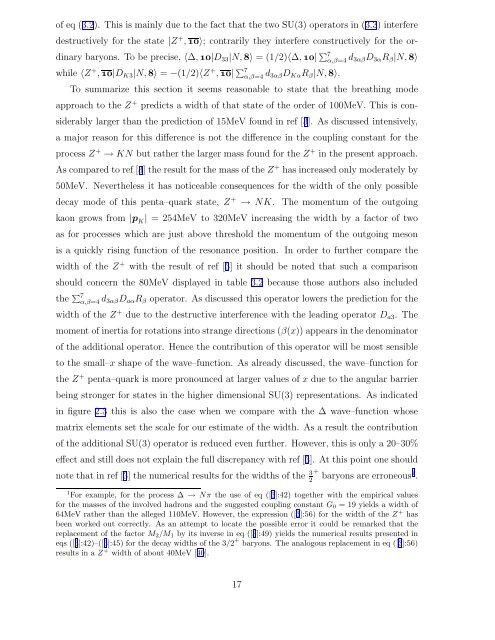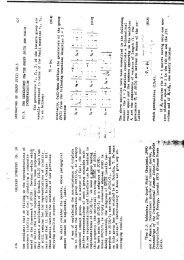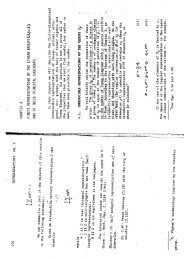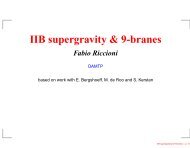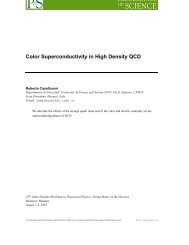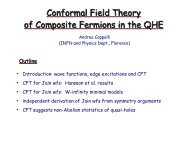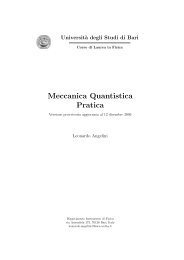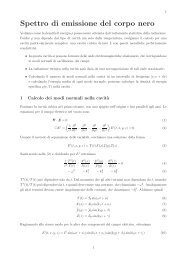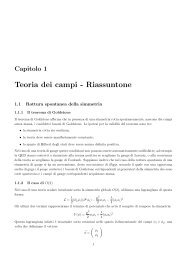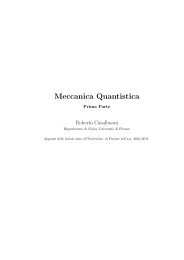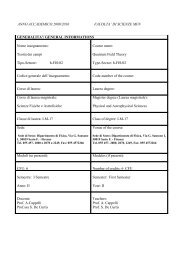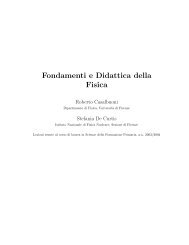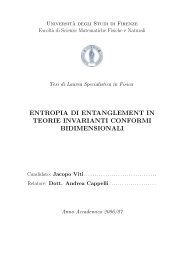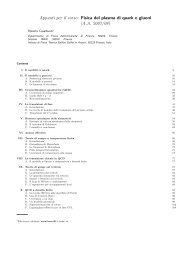arXiv:hep-ph/9804260 v2 16 Jun 1998 - Florence Theory Group
arXiv:hep-ph/9804260 v2 16 Jun 1998 - Florence Theory Group
arXiv:hep-ph/9804260 v2 16 Jun 1998 - Florence Theory Group
Create successful ePaper yourself
Turn your PDF publications into a flip-book with our unique Google optimized e-Paper software.
of eq (3.2). This is mainly due to the fact that the two SU(3) operators in (3.3) interfere<br />
destructively for the state |Z + , 10〉; contrarily they interfere constructively for the or-<br />
dinary baryons. To be precise, 〈∆, 10|D33|N, 8〉 = (1/2)〈∆, 10| 7 α,β=4 d3αβD3αRβ|N, 8〉<br />
while 〈Z + , 10|DK3|N, 8〉 = −(1/2)〈Z + , 10| 7 α,β=4 d3αβDKαRβ|N, 8〉.<br />
To summarize this section it seems reasonable to state that the breathing mode<br />
approach to the Z + predicts a width of that state of the order of 100MeV. This is con-<br />
siderably larger than the prediction of 15MeV found in ref [3]. As discussed intensively,<br />
a major reason for this difference is not the difference in the coupling constant for the<br />
process Z + → KN but rather the larger mass found for the Z + in the present approach.<br />
As compared to ref [3] the result for the mass of the Z + has increased only moderately by<br />
50MeV. Nevertheless it has noticeable consequences for the width of the only possible<br />
decay mode of this penta–quark state, Z + → NK. The momentum of the outgoing<br />
kaon grows from |p K| = 254MeV to 320MeV increasing the width by a factor of two<br />
as for processes which are just above threshold the momentum of the outgoing meson<br />
is a quickly rising function of the resonance position. In order to further compare the<br />
width of the Z + with the result of ref [3] it should be noted that such a comparison<br />
should concern the 80MeV displayed in table 3.2 because those authors also included<br />
the 7 α,β=4 d3αβDaαRβ operator. As discussed this operator lowers the prediction for the<br />
width of the Z + due to the destructive interference with the leading operator Da3. The<br />
moment of inertia for rotations into strange directions (β(x)) appears in the denominator<br />
of the additional operator. Hence the contribution of this operator will be most sensible<br />
to the small–x shape of the wave–function. As already discussed, the wave–function for<br />
the Z + penta–quark is more pronounced at larger values of x due to the angular barrier<br />
being stronger for states in the higher dimensional SU(3) representations. As indicated<br />
in figure 2.3 this is also the case when we compare with the ∆ wave–function whose<br />
matrix elements set the scale for our estimate of the width. As a result the contribution<br />
of the additional SU(3) operator is reduced even further. However, this is only a 20–30%<br />
effect and still does not explain the full discrepancy with ref [3]. At this point one should<br />
note that in ref [3] the numerical results for the widths of the 3+<br />
1 baryons are erroneous .<br />
2<br />
1 For example, for the process ∆ → Nπ the use of eq ([3]:42) together with the empirical values<br />
for the masses of the involved hadrons and the suggested coupling constant G0 = 19 yields a width of<br />
64MeV rather than the alleged 110MeV. However, the expression ([3]:56) for the width of the Z + has<br />
been worked out correctly. As an attempt to locate the possible error it could be remarked that the<br />
replacement of the factor M2/M1 by its inverse in eq ([3]:49) yields the numerical results presented in<br />
eqs ([3]:42)–([3]:45) for the decay widths of the 3/2 + baryons. The analogous replacement in eq ([3]:56)<br />
results in a Z + width of about 40MeV [40].<br />
17


